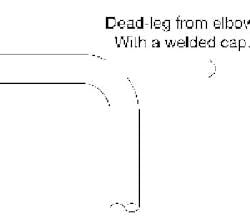Piping dead-legs remain a persistent source of plant maintenance and safety incidents. Not a year passes without a major fire or process fluid release due to dead-legs. These problems have been long known. Thirty years ago, as a beginning engineer, I prepared a rough sketch to explain required modifications to a piping layout. This drawing caused much excitement — not because of the changes needed but because of the existing dead-legs shown. After years of hunting and removing dead-legs, the plant still had many waiting to be found.
Dead-legs merit special attention to maintain asset integrity and prevent incidents. Well-run plants will have dead-leg elimination, special inspection, and preventive maintenance programs. However, different plants may classify different things as dead-legs.
So, what qualifies as a dead-leg? Piping segments continuously exposed to the process but without normal flow or provision for flow, including lines closed by flanges, welded caps or other fittings, nearly always are considered dead-legs. However, other situations are trickier to classify. Two particular issues that perplex the most are dealing with intermittent flow lines and defining how much line is required for something to be classified as a dead-leg.
Commonly, batch-system piping used on an intermittent but reasonably frequent scheduled basis isn't considered a dead-leg. This seems simple but leaves a lot of room for honest disagreement. Most would agree that a pipe regularly used once a day isn't a dead-leg. Many would treat a pipe used roughly once a year and only for a few minutes as a dead-leg. But what about the intermediate situations? For instance, does a pipe used once a month on a scheduled basis for several hours count as a dead-leg?
The decision should rest on the likely problems that may occur in a specific process and piping segment. Incident reviews show that two major events cause the vast majority of dead-leg problems: water freezing and localized corrosion.
Piping Geometry: Grasp Line Layout
Mind Piping System Mechanics
Challenge Pipe Specifications
Provide Better Protection from Hot Pipes
The volume expansion as water turns into ice may rupture a piping system. This can lead to immediate process fluid escape if the system pressure can push the ice plug out. At other times, the ice plug can keep a crack sealed until the system starts to warm. Then, once the ice melts, process fluid escapes.
Unusually cold weather most commonly causes ice plugs. However, freezing also can result from autorefrigeration from process pressure drops. Any piping can crack. Plastic piping is especially vulnerable because at low temperatures many common polymers become brittle.
Localized corrosion can present more-complex difficulties. It can create problems even in very short line segments. Some questions to ask include:
Are corrosion inhibitors in use? If so, will there be enough turbulence to get inhibitors to the surface of a non-flow pipe component? In laminar flow systems this can be a big problem.
Could temperature differences change corrosion mechanisms? Lack of flow allows process piping to move to ambient temperature. Could that temperature change the corrosion mechanisms? Could it prompt water to condense or separate out?
Can process composition change over time? Lack of flow can enable unexpected reactions to go to completion. Contaminants normally at low concentrations may accumulate. On the other hand, lower levels of some components could reduce the protection they might give the material surface. Many metals benefit from protective layers generated by reacting with the process. What happens to these layers over time?
Can solids accumulate? Special corrosion mechanisms may occur under a solids' deposit.
Depending upon the answers to these questions and other particular circumstances, piping systems with intermittent or rare use may require special materials.
Let's look at two rules-of-thumb: one for freezing and another for corrosion.
To address freezing, anything longer than a tee connection to a blind flange or valve is too long unless a plant provides protection measures such as heat tracing, insulation, circulation systems, additives, etc. Flanges on the unused branch of a tee fitting haven't suffered an excessive number of problems due to freezing. However, the amount of incidents increases when line is attached to the tee.
One way to ensure that rarely used pipe segments, including lines to pressure relief valves and connections between piping systems, don't suffer water problems is to make them come out the top of a line and not have pockets.
For corrosion protection, any branch from the flowing line that has a length/diameter ratio exceeding three likely will cause a problem. Avoid branches with elbows or secondary tee connections.
For welded-cap (Figure 1) or fused-cap connections, consider any length of pipe without flow a dead-leg. The real question for a capped pipe is why it's there. If you can cut off a cap to get into a pipe, you usually can cut into the pipe itself.
Sometimes a dead-leg is necessary — for example, you might put pipe in during a shutdown that won't be used for a long time. In such situations, consider special arrangements that isolate the pipe from the process, use special materials to reduce corrosion, or arrange required preventive maintenance.
These rules-of-thumb and pointers provide some guidance about analyzing and addressing dead-legs. However, you must use engineering knowledge for your specific system to decide what must be done.
About the Author
Andrew Sloley, Plant InSites columnist
Contributing Editor
ANDREW SLOLEY is a Chemical Processing Contributing Editor.


